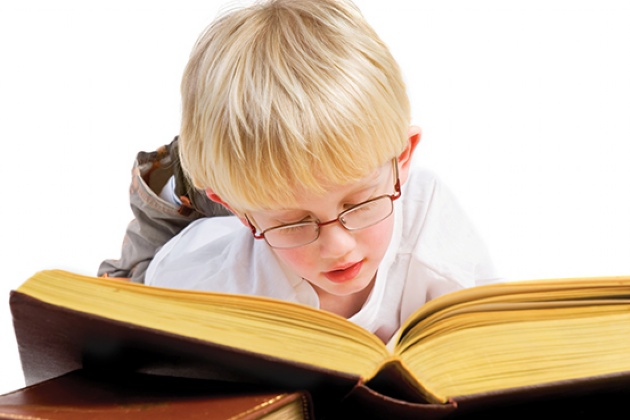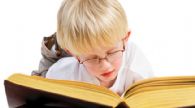Concerned,
loving and conscientious parents can be counted on to visit the clinic or
family doctor (pediatrician) when their child is visibly suffering from
flu-like symptoms or in the case of other ailments that are physically apparent,
but what about the invisible complaints? What about the conditions that have
the innate ability to hide from the naked eye?
It
has been found that approximately 80<>percentage<> of how children learn in the first twelve
years of life is visual and yet only about 6<>percentage<> of parents notice vision
difficulties. According to a survey by the Canadian Association of Optometrists,
61<>percentage<> of parents mistakenly thought they would know if their child had vision
weaknesses. This is not to admonish parents but to let them know that it is a
very common oversight for lack of a better word.
If
a child is suffering from lower grades in school it is imperative that a
team-type approach is taken, beginning with the least invasive path. Of course,
there are other considerations but good vision with regards to learning is a crucial
starting point. There is a long list of
things to watch out for aside from lower grades when it comes to vision
difficulties. A partial list includes; the child found to be frequently
daydreaming, often rubbing their eyes, squinting or covering one eye, complaining
of headaches, dizziness. Also, holding a book too close or tilting the head in
order to read and always using their finger as a guide while reading are all signs
to watch out for.
Often
the child himself/herself doesn’t realise that they have a vision problem
because they have no bench mark and, therefore, no idea what perfect vision is.
The result of poor eyesight can be a fidgety, disinterested child who falls
behind simply because they are not able to remain engaged the way the rest of
the class is. They wrongly assume they see the same way everyone else does. Poor
vision can also wreak havoc on hand-eye coordination and fine motor skills. The
combination of results can have an impact, not only on learning and grades but
on quality of life.
Canadian
ophthalmologists recommend that children start having eye examinations at the
age of three and continue on a yearly basis for the rest of their life. An
earlier examination would be warranted if the infant or toddler appears to be
cross-eyed or demonstrates similarly obvious symptoms. Luckily, we in Quebec
have access to eye care specialists whose examination fees are covered under
RAMQ (once a year exam, not including drops). When it comes to children, it is
best when calling for an appointment with either an ophthalmologist or an
optometrist that an inquiry is made as to whether they are equipped to test
children. Otherwise, getting a referral from a family doctor or pediatrician is
recommended.
Poor
vision is not always a condition that is treated by corrective eye glasses. It
really depends on the root cause of the problem. There are eye function
problems where the eyes tend not to align while reading, lazy eye, perception
problems and color blindness along with common near and far-sightedness, astigmatism
as well as various eye disease(s). Depending on the problem some functional
difficulties require vision therapy, medication or no intervention,
as opposed to having to wear corrective eyeglasses.
Visiting
http;//opto.ca
will provide further insight into the correlation between vision and learning
as well as discuss the importance of fundamental development and early
detection. The Doctors of Optometry Canada have earmarked the month of October
as Children’s Vision Month but why wait until then when prevention can start
right away.
About the
Author;
Lesley
Fletcher is an author of four books and a freelance writer living in the
suburbs of Montreal. She is currently working on her next book. More on her
books and art, as well as contact information can be found at her website; www.lesleyfletcher.com Spirit,
Soul, Life.

 In The Latest Issue:Latest Issue:
In The Latest Issue:Latest Issue:
- A Bittersweet Farewell
- The new Laval Aquatic Co...
- The End of an Era:
Articles
Calendar
Virtual- ANNUAL TEACHER APPRECIATION CONTEST
- APPUI LAVAL
- ARTS & CULTURE
- CAMPS
- CAR GUIDE
- CCIL
- CENTENNIAL ACADEMY
- CHARITY FUNDRAISING
- CITYTV
- COSMODÔME
- COMMUNITY CONNECTIONS
- COVER STORY
- DINA DIMITRATOS
- ÉCOLE SUPÉRIEURE DE BALLET DU QUÉBEC
- EDITORIALS
- ÉDUCALOI
- EDUCATION
- EMPLOYMENT & ENTREPRENEURSHIP
- FÊTE DE LA FAMILLE
- FÊTE DU QUARTIER SAINT-BRUNO
- FAMILIES
- FESTIVAL LAVAL LAUGHS
- FÊTE DE QUARTIER VAL-DES-BRISES
- FINANCES
- GLI CUMBARE
- GROUPE RENO-EXPERT
- HEALTH & WELL-BEING
- 30 MINUTE HIT
- ANXIETY
- CHILDREN`S HEALTH & WELLNESS
- CLOSE AID
- DENTAL WELLNESS
- EXTREME EVOLUTION SPORTS CENTRE
- FONDATION CITÉ DE LA SANTÉ
- GENERAL
- HEARING HEALTH
- MESSAGES FROM THE HEALTH AGENCY OF CANADA
- MENTAL HEALTH
- SEXUALITY
- SOCIAL INTEGRATION
- SPECIAL NEEDS
- TEENS
- THE NUTRITION CORNER
- THE NUTRITION CORNER - RECIPES
- VACATION DESTINATION
- WOMEN'S FITNESS
- WOMEN'S HEALTH
- HILTON MONTREAL/LAVAL
- HOME & GARDEN
- INTERNATIONAL WOMEN'S DAY
- JAGUAR LAVAL
- LAVAL À VÉLO
- LAVAL FAMILIES TV SHOW
- LAVAL FAMILIES MAGAZINE CARES
- LAVAL URBAN IN NATURE
- LE PARCOURS DES HÉROS
- LES PETITS GOURMETS DANS MA COUR
- LEON'S FURNITURE
- LEONARDO DA VINCI CENTRE
- LFM PREMIERES
- LIFE BALANCE
- M.P. PROFILE
- MISS EDGAR'S AND MISS CRAMP'S SCHOOL
- MISSING CHILDREN'S NETWORK
- NETFOLIE
- NORTH STAR ACADEMY LAVAL
- OUTFRONT MEDIA
- PASSION SOCCER
- PARC DE LA RIVIÈRE-DES-MILLE-ÎLES
- PÂTISSERIE ST-MARTIN
- PIZZERIA LÌOLÀ
- PLACE BELL
- PORTRAITS OF YOUR MNA'S
- ROCKET DE LAVAL
- SACRED HEART SCHOOL
- SCOTIA BANK
- SHERATON LAVAL HOTEL
- SOCIÉTÉ ALZHEIMER LAVAL
- STATION 55
- STL
- SUBARU DE LAVAL
- TECHNOLOGY
- TEDXLAVAL
- TODAY`S LAURENTIANS AND LANAUDIÈRE
- TODAY`S LAVAL
- WARNER MUSIC
- THIS ISSUE
- MOST RECENT
Magazine
Healthy Vision is Key to a Child’s Capacity to Learn
Articles ~e 105,7 Rythme FM 4 chemins Annual Teacher Appreciation Contest Appui Laval Arts & Culture Ballet Eddy Toussaint Camps THIS ISSUE MORE...
CONTESTS Enter our contests
CONTESTS Enter our contests
CALENDAR
Events & Activities
COMMUNITY Posts Events
PUBLICATIONS Our Magazine Family Resource Directory
LFM BUSINESS NETWORK Learn more
COUPONS Click to save!
COMMUNITY Posts Events
PUBLICATIONS Our Magazine Family Resource Directory
LFM BUSINESS NETWORK Learn more
COUPONS Click to save!
SUBSCRIPTIONS
Subscribe to the magazine
Un-Subscribe
E-NEWSLETTER Subscribe to our E-newsletter Un-Subscribe
WRITE FOR US Guidelines & Submissions
POLLS Vote today!
E-NEWSLETTER Subscribe to our E-newsletter Un-Subscribe
WRITE FOR US Guidelines & Submissions
POLLS Vote today!
ADVERTISERS
How to & Media guide
Pay your LFM invoice
SUGGESTIONS Reader's Survey Suggest a Listing
LFM About Us Our Mission Giving Back Contact Us
SUGGESTIONS Reader's Survey Suggest a Listing
LFM About Us Our Mission Giving Back Contact Us
 PICK-UP LOCATIONS
Get a copy of LFM!
PICK-UP LOCATIONS
Get a copy of LFM!
TERMS & CONDITIONS Privacy | Terms
ISSN (ONLINE) 2291-1677
ISSN (PRINT) 2291-1677
Website by ZENxDESIGN



 BY:
BY: 
Tweet
Share